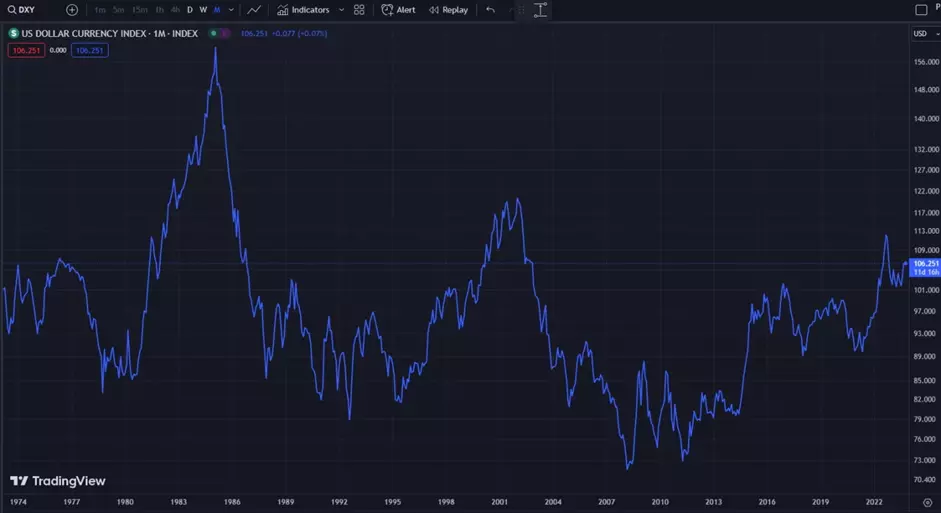DXY Index: Measuring the U.S. Dollar's Strength
DXY, or the U.S. Dollar Index, is a financial instrument that measures the relative strength of the U.S. dollar against a basket of six major world currencies, including the euro, Japanese yen, British pound, Canadian dollar, Swedish krona, and Swiss franc.
DXY, otherwise known as the U.S. Dollar Index, is an instrument in the financial market that gauges the relative strength or weakness of the U.S. Dollar against other major world currencies.It gives financial traders, economists, etc., insights into the performance of the U.S. Dollar in the financial market. When the value of the index rises, it suggests that the U.S. Dollar is gaining strength against the major currencies, while a decrease in the value indicates that the U.S. Dollar is weak. Read to the end to find more details about the importance of the DXY, the model used for calculation, and how it works in the financial market.
What Exactly is the U.S. Dollar Index (DXY)?
The DXY is a widely used tool in the global financial market that measures the strength or weakness of the U.S. Dollar against other major currencies. It holds significant value in the financial market because it provides information that helps traders, economists, and investors to make informed financial and economic decisions.
DXY was established in 1973 by the U.S. Federal Reserve after the Bretton Woods system (an agreement that recognizes gold as a standard for currency exchange rate) ended. The DXY has been managed by the Intercontinental Exchange (ICE) since 1985 and has become a reference point for financial traders, investors, and economists to make better financial decisions.
DXY measures the value of the U.S. Dollar against six baskets of currencies with varying degrees of weight. The Euro is the second most traded currency in the world and has the largest weight in the DXY at 57.6%. The JPY has a total weight of 13.6%, CAD weighs 9.1%, GBP weighs 11.95, CHF weighs 3.6%, and (SEK) weighs 4.2%.
The DXY works with a base year of 1973 and a base value set at 100. So, an index value above 100 indicates that the U.S. Dollar is stronger in value than other currencies. For context, if the index value is 110, for instance, it indicates that the U.S. Dollar is 10% stronger in value than other basket of currencies.
Similarly, when the index falls below 100, say 90, for instance, It indicates that the value of the U.S. Dollar has dropped (becomes weaker) by 10% than the other basket of currencies.
Therefore, financial traders use the DXY during technical and fundamental analysis to make trade projections and to find optimal zones for a buying or selling opportunity. For instance, a trader may monitor the DXY for a trend reversal signal at a support or resistance level for an opportunity to buy or sell other financial instruments.
So, a weaker (bearish) DXY suggests that currency pairs with the U.S. dollar as the quoted currency (e.g., EUR/USD) would likely be bullish. Similarly, a stronger DXY may influence currency pairs with the U.S. dollar as the base to move to the downside (bearish).
Conversely, currency pairs with the U.S. dollar as the quoted currency tends to move in the direction of the DXZ. So, a currency pair like the USD/CHF, for instance, would most likely trend to the upside (bullish) when the DXY is stronger.

U.S. Dollar Index
Best Forex brokers

Related Terms for Beginners
-
Balance of Trade: Balance of trade entails the difference between a country’s export and import value over a specific time. In other words, it refers to the trade balance between the import and export value. Balance of trade is one of the indices used to determine the strength or weakness of a country's economy.
-
Risk-on: The term risk-on implies that investors are optimistic about the potential performance of a financial asset or economic conditions, thereby willing to take more risk.
-
Risk-off: This is the opposite of “risk on”. Here, investors lose confidence in the stability of a financial asset or economic environment overall, thus moving their investment to a more stable asset.
-
Safe Haven Currency: A safe haven currency is a relatively stable asset that is less likely to lose its value during financial crises caused by uncertainty (e.g., war, natural disaster, etc.). Therefore, investors tend to move their investment to a safe-haven currency during turbulence in the financial markets. An example of a common safe-haven currency is the U.S. Dollar because it is the global reserve currency.
How does DXY work?
The DXY is calculated based on the exchange rate of the U.S. Dollar against each of the six baskets of currencies. It is calculated using the following formula:
DXY= 50.14348112 * (EUR/USD)^(-0.576) * (JPY/USD)^(0.136) * (GBP/USD)^(-0.119) * (CAD/USD)^(0.091) * (SEK/USD)^(0.042) * (CHF/USD)^(0.036)
Example of U.S. Dollar Index use cases
Forex Trading - Traders analyze DXY to gauge the overall direction of the U.S. dollar. Traders combine DXY analysis with technical and fundamental analysis of specific currency pairs like EUR/USD.
Market Analysis - Analysts across asset classes monitor DXY to understand the impacts of currency fluctuations on commodities, equities, bonds, and other markets. A weaker dollar tends to benefit U.S. multinational companies for example.
Portfolio Hedging - Investors use DXY futures contracts, options, and funds that track the index to hedge the currency exposure and risk in global investment portfolios.
Pair Trading - Traders look for divergences between DXY and currency pairs like USD/JPY to implement pair trades for additional alpha.
Position Sizing - Traders may adjust the size of positions in dollar-denominated assets based on the prevailing strength or weakness reflected in the DXY.
Sentiment Indicator - DXY is monitored as a barometer of market sentiment towards the U.S. economy.
FAQ
Why is the Euro the biggest component of the DXY?
The Euro holds the biggest component of the DXY because it is the second most traded currency in the world. It is the currency of the Eurozone, one of the major trading partners of the United States. Besides, it is one of the most used reserve currencies in the world.
How often is the DXY calculated and updated?
DXY is calculated and updated in real trading time, approximately every 15 seconds. The data is also redistributed in real-time by the Intercontinental Exchange across all data vendors.
Can the DXY predict economic trends?
DXY reflects the strength or weakness of the U.S. dollar in the financial market and does not predict economic trends. However, it can be used as a confluence with price action/other economic indicators to predict the economy of the market.
How is DXY different from other dollar indexes?
One of the differences between the DXY and other dollar indexes is in the type of currency included in the basket. The DXY is used to compare the U.S. Dollar against the six major world currencies (EUR, SEK, JPY, GBP, CAD, and CHF), while other indexes cover broader currencies.
Team that worked on the article
Upendra Goswami is a full-time digital content creator, marketer, and active investor. As a creator, he loves writing about online trading, blockchain, cryptocurrency, and stock trading.
Professionally, he has been a marketing professional running his agency for three years now. His agency helps finance projects to grow with the help of internet technologies. Upendra Goswami is an active investor and enthusiast of stocks and cryptocurrency.
Knows about
trading, blockchain, cryptocurrency, stock trading
Alumnus of
JECRC UDML College of Engineering, Jaipur
Dr. BJ Johnson is a PhD in English Language and an editor with over 15 years of experience. He earned his degree in English Language in the U.S and the UK. In 2020, Dr. Johnson joined the Traders Union team. Since then, he has created over 100 exclusive articles and edited over 300 articles of other authors.
The topics he covers include trading signals, cryptocurrencies, Forex brokers, stock brokers, expert advisors, binary options. He has also worked on the ratings of brokers and many other materials.
Dr. BJ Johnson’s motto: It always seems impossible until it’s done. You can do it.
Mirjan Hipolito is a journalist and news editor at Traders Union. She is an expert crypto writer with five years of experience in the financial markets. Her specialties are daily market news, price predictions, and Initial Coin Offerings (ICO). Mirjan is a cryptocurrency and stock trader. This deep understanding of the finance sector allows her to create informative and engaging content that helps readers easily navigate the complexities of the crypto world.










